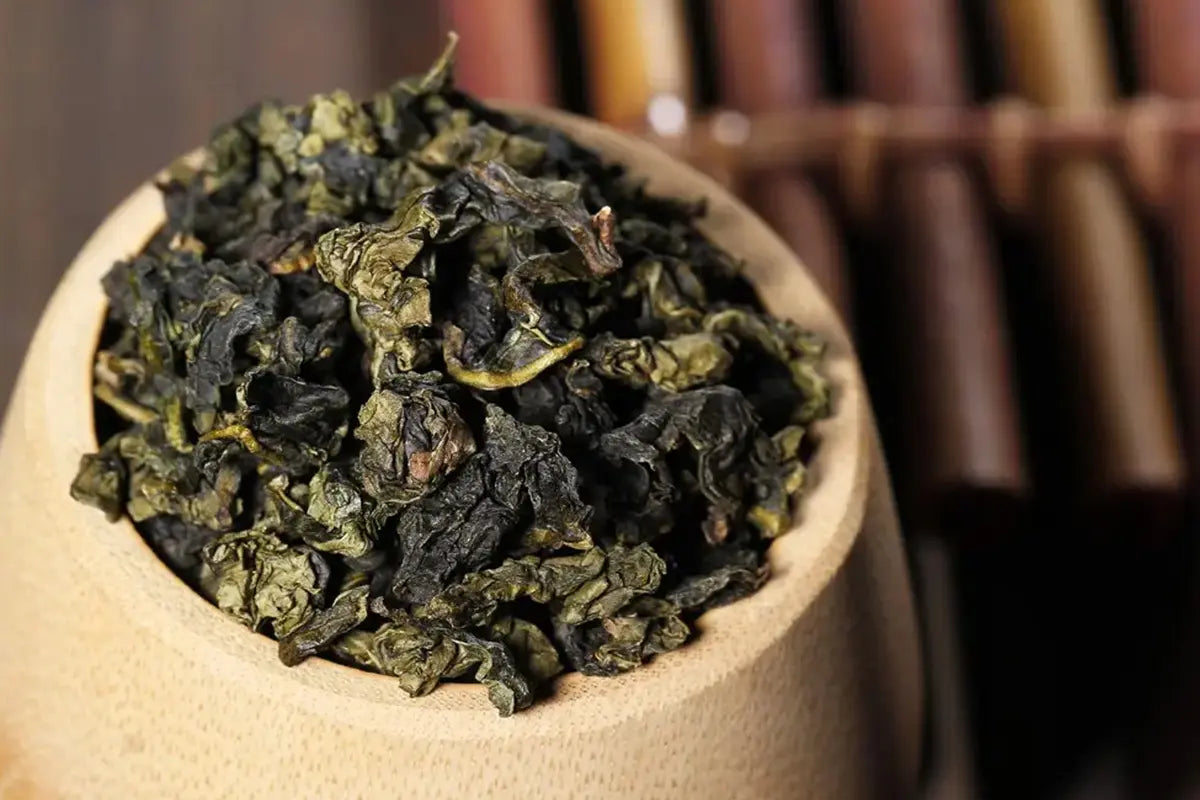Когда речь заходит о китайском листовом чае, вы, возможно, слышали о ТеГуаньинь. ТеГуаньинь очень популярен в Китае , и его присутствие можно найти в различных чайных домах и ресторанах от севера до юга. ТеГуаньинь можно считать синонимом китайского чая улун.
Итак, почему же ТеГуаньинь так хорошо принят? Популярность ТеГуаньинь тесно связана с его пленительным вкусом и ароматом, превосходными условиями выращивания, превосходными сортами чайных деревьев и изысканными методами производства, среди прочих факторов.
Что такое чай Тегуаньинь?

TieGuanyin имеет высокую репутацию среди десяти самых известных чаев Китая и является одним из лучших листовых чаев . TieGuanyin — это не только название чая, но и название сорта чайного дерева. Его название происходит от его листьев, которые тяжелы как железо, а его внешний вид прекрасен, а внутреннее качество напоминает Гуаньинь. Поскольку он производится в уезде Аньси, его часто называют «Anxi TieGuanyin».
Чай ТеГуаньинь находится между зеленым и черным чаем, относясь к категории полуферментированного чая. Он обладает уникальным «очарованием Гуаньинь», с чистым и элегантным ароматом. После заваривания ТеГуаньинь имеет натуральный аромат орхидеи, чистый и крепкий вкус и стойкий, насыщенный аромат, заслужив репутацию «оставающегося ароматным более семи заварок».
Помимо ТеГуаньинь, Китай также может похвастаться различными классическими чаями улун, такими как Да Хун Пао , Фэнхуан Даньцун, каждый из которых обладает своими собственными отличительными характеристиками, которые оставляют неизгладимое впечатление после употребления. Подарочные наборы китайского чая улун станут отличными подарками для семьи и друзей.
Вкус и аромат Тегуаньинь

ТеГуаньинь можно разделить на три типа: Цинсян (легкий аромат), Нунсян (сильный аромат) и Чэньсян (выдержанный аромат). Чтобы определить, какой тип ТеГуаньинь лучше всего соответствует вашим предпочтениям, рекомендуется попробовать пробный чай , купив небольшое количество и открыв для себя тот ТеГуаньинь, который вам понравится.
1.Цинсян (Легкий аромат) Те Гуаньинь
Цинсян Тегуаньинь высушивается при низкой температуре. Он имеет глянцевый, нефритово-зеленый цвет, чистый и освежающий аромат, свежий вкус, а чайный настой золотисто-желтый с оттенком зеленого.
2.Нунсян (Сильный аромат) Те Гуаньинь
Nongxiang TieGuanyin высушивается путем запекания. Его внешний вид, как правило, более темный и блестящий. Он отличается богатым и стойким ароматом со сложными цветочными и карамельными нотами. Вкус мягкий, а ликер золотисто-желтый с оттенком апельсина.
3. Чэньсян (Выдержанный аромат) Те Гуаньинь
Chenxiang TieGuanyin — это Qingxiang или Nongxiang TieGuanyin, который хранился не менее пяти лет после выпечки. Чайные листья имеют темно-коричневый цвет с легким желтоватым оттенком. Выдержанный аромат очевиден, а вкус мягкий. Настой прозрачный, темно-красного цвета.
Превосходная среда выращивания TieGuanyin
Округ Аньси может похвастаться уникальной географической средой с прекрасными почвенными и климатическими условиями. Весь округ охватывает диапазон высот от 40 до 1000 метров, спускаясь с северо-запада на юго-восток. Восточная половина состоит в основном из невысоких холмов и хребтов, с высотами, как правило, от 100 до 300 метров. Рельеф относительно ровный, с многочисленными речными долинами и равнинами.
Западная половина имеет более крутой рельеф, с высотами в основном от 600 до 800 метров. Район характеризуется перекрывающимися горными вершинами, окутанными облаками и туманом, и попадает под субтропический муссонный климат. Здесь обильные осадки, четкие времена года, со средней годовой температурой от 16 до 21 °C и годовым количеством осадков от 1600 до 1800 миллиметров. Тегуаньинь процветает и процветает в такой уникальной природной и географической среде.
Сорта чайного дерева Тегуаньинь

Аньси — известный источник превосходных сортов чайного дерева в Китае, история производства чая насчитывает более тысячи лет. Этот регион производит разнообразные виды высококачественного листового чая . В округе выявлено более сорока сортов чайного дерева, и ТеГуаньинь входит в число превосходных сортов.
История выращивания Тегуаньинь насчитывает более 300 лет. Растения имеют кустарниковую структуру роста с раскидистой кроной и ветвями, которые наклонены вверх. Листья расположены горизонтально, эллиптические, со слегка вогнутыми и наклонными кончиками листьев. Края листьев редко-тупозубчатые, с небольшим завитком назад. Листья толстые и имеют волнистую выпуклую форму, демонстрируя четкие ребристые узоры. Листья темно-зеленого цвета, блестящие, а нежные побеги пухлые с легким фиолетовым оттенком, обычно известные как «красный бутон с закрученным хвостом персика». Период бутонизации относится к поздним бутонизирующим сортам около весеннего равноденствия.
Изысканное мастерство Тегуаньинь

Красота ТеГуаньинь неотделима от точности методов ее производства в Аньси. Мастерство ТеГуаньинь было признано нематериальным культурным наследием национального уровня в Китае еще в 2008 году.

Стандарты сбора свежих листьев для Тегуаньинь очень высоки. Сбор урожая должен проводиться после того, как нежные побеги сформируют почки, и когда верхние листья только начинают слегка раскрываться с небольших или средних поверхностей. Затем собирают второй и третий листья. После традиционного процесса производства свежесобранные листья проходят более дюжины этапов, включая охлаждение, сушку на солнце, дополнительное охлаждение, Цзоцин, обжиг на сковороде, скручивание, первичную выпечку, упаковку, вторичную выпечку, вторичную упаковку, медленную обжарку на слабом огне и сортировку, прежде чем можно будет произвести очищенный чай.
Среди этих шагов, техническая сторона и гибкость, используемые в Цзоцине, имеют решающее значение в производстве листового улуна, а также являются ключевыми факторами качества ТеГуаньинь. Процесс встряхивания Цзоцина включает перемешивание листьев, вызывающее трение по краям и разрушение клеток на краях листьев. После перемешивания листьям дают отдохнуть, и по мере того, как влага постепенно испаряется при определенных условиях температуры и влажности, полифенолы в листьях подвергаются ферментативным реакциям и медленно окисляются. Это приводит к серии химических изменений, что приводит к появлению отличительных качеств чая улун, включая ТеГуаньинь.
Надеюсь, эта статья поможет каждому лучше понять ТеГуаньинь, помогая понять причины популярности этого чая. Элегантный цветочный аромат и освежающее послевкусие ТеГуаньинь пленили многих. Возможно, понимание ТеГуаньинь у каждого человека может отличаться, но это не мешает нашей коллективной любви к этому чаю и нашему общему наслаждению его красотой.












































































